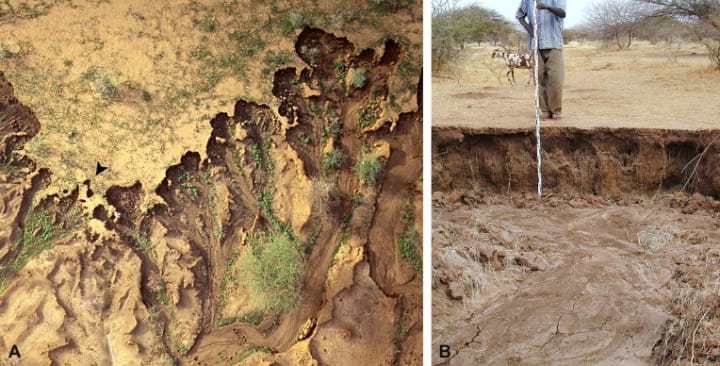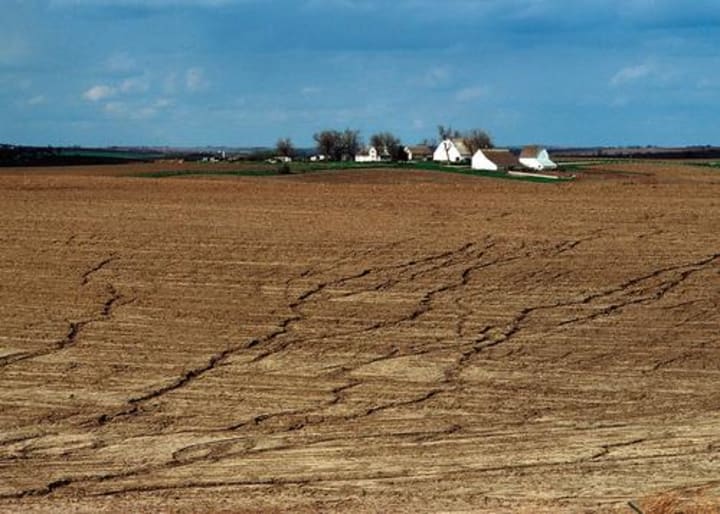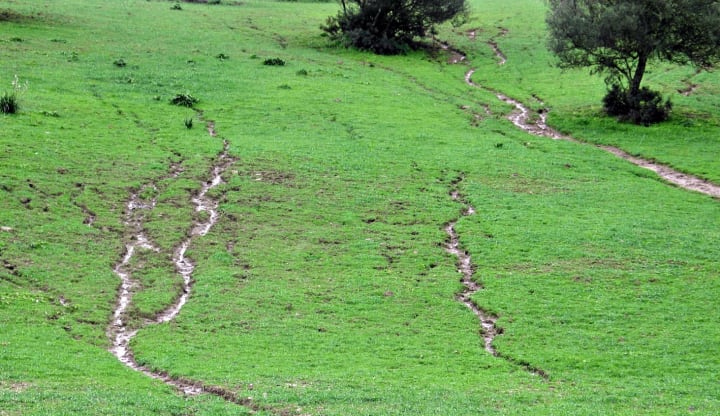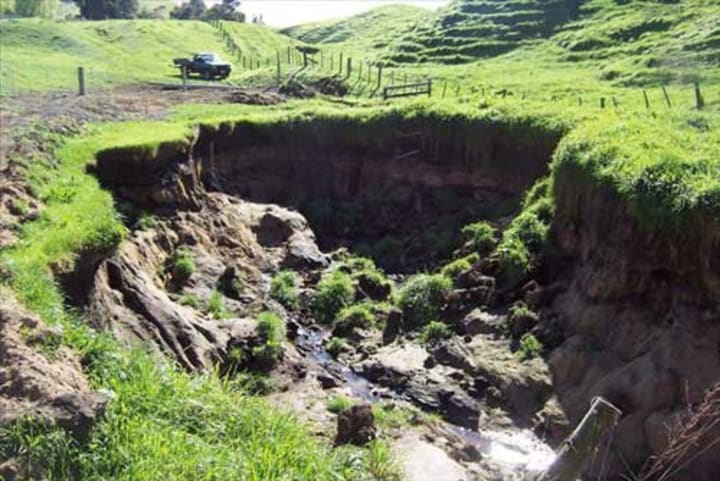TYPES OF SOIL EROSIONS, THEIR DEFINITIONS, THEIR CAUSES, THEIR NEGATIVE EFFECTS, AND MEASURES TO PREVENT THEM.
Environment

Introduction
THIS ARTICLE IS ABOUT THE TYPES OF SOIL EROSIONS, THEIR DEFINITIONS, THEIR CAUSES, THEIR NEGATIVE EFFECTS, AND MEASURES TO PREVENT THEM. The soil is the outermost part of the earth that covers the earth's surface; it is home to some organisms, humans cultivate the soil for food and build shelters on them. If our soil is not well taken care of, it might not be able to provide the requirements needed for human use.

What is soil erosion?
Soil erosion is defined as the washing away of the topsoil by running rainwater or wind as they move over lands that are not covered. Soil erosion affects almost all types of land ranging from highlands, slopes, and lowlands.
Two Main Factors That Causes Soil Erosions
1. Water: It is involved in the four main types of soil erosion; when land surfaces are exposed due to some activities, moving water over them can lead to soil erosion.
2. Wind: This is another agent that is responsible for soil erosion; it mainly occurs on sandy soil or soils in which particles are suspended after a light rainfall. Wind is not an agent in all four main types of erosion.
There are four main types of soil erosions: Splash Erosion, Sheet Erosion, Rill Erosion, and Gully Erosion.
Splash Erosion

It is the less aggressive and first form of soil erosion; it occurs when light rain falls on grounds that are not covered. Rain droplets over time cause tiny soil particles to become loose; if preventive measures are not taken over time, these soil particles will be blown away by winds. Further rainfall over time will transport and deposit these loose soil particles to another location causing a less aggressive form of erosion called splash erosion.
Sheet Erosion

Is the uniform washing away of the top soils by moving water that does not infiltrate the ground; sheet erosion causes landslides mostly on sloped lands. This type of erosion is mostly a result of rainfall after splash erosion has occurred.
Rill Erosion

This is the type of erosion that is observable during continued rainfall; during continued rainfall along roads/walkways or along lands that are not covered and where there is no proper drainage system, rainwater forms straight or narrow channels called streamlets to flow. If this continues over time and preventive measures are not implemented, rill erosion will progress to gully erosion.
Gully Erosion

This type of erosion occurs during continued heavy rainfalls along unpaved roads and walkways and along sloped lands; continued rainfall over a long period along these paths causes drainage pathways for running water to flow. These drainages can be so deep that they can render major or feeder roads useless.
CAUSES OF SOIL EROSION
The major causes of soil erosion are Deforestation, Bushfires, Overgrazing by livestock, Sand winning, etc.
Deforestation

It is the illegal practice of cutting down trees- without replanting them- by humans for activities such as materials for building and various types of construction work, for manufacturing of finished furniture, firewood, etc. The roots of trees help to keep soils compact, preventing soil erosion during rainfall. Branches of trees serve as windbreaks, the passing of heavy winds. On sloped lands- lands around hillsides- the compatibility of soils caused by the roots of trees prevents sheet erosion; the branches of trees planted along sandy grounds serve as windbreaks preventing erosion caused by wind.
Bushfires

It is defined as the intentional or unintentional setting of fire on a portion of land that can be controllable or uncontrollable. Some of the main causes of bushfires are clearing land for agricultural purposes, fires caused by hot weather due to climate change, throwing of used cigarettes into bushes by smokers, etc. After a bushfire and trees are not replanted nor plants cultivated on these lands, they are exposed to continuous rainfall leading to soil erosion.
Overgrazing by Livestock

This is the practice whereby a large group of animals- mainly herbivores- feed on a portion of land for a long period. Over time, the continuous feeding and movement of these animals on a portion of land makes such land barren; soil erosion may occur on these lands during heavy rainfall.
Sand winning

It is the practice of continually transporting large portions of sand from a particular location for various purposes such as building houses, construction of roads, etc. This practice involves the clearing of lands to expose their surfaces for proper extraction of sand thereby exposing these lands to rainfall leading to soil erosion.
NEGATIVE EFFECTS OF SOIL EROSION
Soil erosion has negative effects, pointing out these negative effects can help us put some measures in place to prevent these practices that cause soil erosion; below are some of the negative effects of soil erosion.
1. Poor Farming and Low Yield of Farm Products: Soil erosion, if not properly managed, can render farmlands useless or prevent proper crop yield. The washing of top soils during sheet erosion can wash crops along with moving water; if crops are not grown, washing away of fertile top soils on farmlands can also wash away important nutrients that would be needed for proper plant growth. Gully erosion on farmlands would render it useless for cultivating crops.
2. Rendering Roads Useless: Gully erosion can render motor roads useless; rill erosion, if not managed over time develops into gully erosion rendering busy unpaved motor roads useless. Roads that are not paved and poorly constructed with no drainage to allow running rainwater to flow may over time develop gully erosion if rainwater creates channels on these roads.
3. Landslides and Lost of Lives and Properties: Continued flow of running water down a slope without trees, plants, or cover crops can lead to landslides; if there are residences located down such slope, landslides can lead to loss of lives and properties.
4. Lost of Revenue to Individual and State: Soil erosion can lead to a loss of revenue to both individuals and state; farmers, especially those who are involved in large-scale farming, whose farmlands containing crops washed away due to soil erosion caused by rainfall would cause a lost of revenue. The cost involved in cultivating farmland- from clearing the land, buying seedlings/seeds, fertilizer, paying for labor, etc.- would cast the farmer a financial burden when his/her farmland is washed away by soil erosion due to running water. Poorly constructed roads- major and feeder roads- constructed by the government along waterways without proper drainage systems may experience gully erosion rendering these roads useless and causing financial losses to the state.
MEASURES TO PREVENT SOIL EROSION
Below are some measures that are kept in place to minimize and prevent soil erosion:
1. Afforestation and Reafforestation: Afforestation is the process of planting trees on a barren land for the first time whereas reafforestation is the replanting of trees on lands that previously had trees but were cut down for agricultural purposes, making furniture, for firewood, destroyed as a result of bushfire, etc. Trees planted serve as windbreaks preventing wind erosion; the roots of trees hold soil particles together preventing soil erosion caused by water. Afforestation and reafforestation are mostly effective along level grounds.
2. Terrace Farming: This is the type of farming carried out along slopes of hills; soils along slopes of hills are cut into steps, as rainwater carrying soil particles flow from one step to another, soil particles are trapped by preceding steps thereby slowing down soil erosion; soil therefore are not completely lost.
3. The Use of Cover Crops: Cultivating cover crops along slopes of hills/highlands can slow down and prevent soil erosion; cover crops grow in such a way that they cover the surfaces of the land on which they are cultivated. Covering land surfaces with cover crops prevents direct exposure of these land surfaces to running water and windstorms thereby preventing soil erosion.
4. Preventing Overgrazing by Livestock: Preventing overgrazing by livestock can minimize soil erosion and its effects; farm animals should not be allowed to feed on a piece of land over a long period. They should be transported from one farmland to the other over time to graze to prevent overgrazing.
5. Preventing Excessive Sand Winning: The excessive removal of sand from a particular location over a long period should be minimized to prevent sand winning. After sand winning is carried out on lands, holds created should be filled with dirt, and crops cultivated over these lands or trees grown along its edge to prevent soil erosion by both running water and moving wind.
Conclusion: Soil erosion can be prevented if measures are kept in place to check activities that cause it; the government should create organizations to protect our forest from illegal activities such as deforestation, overgrazing, excessive sand winning, etc. There should be a day set aside each year for the planting of trees nationwide. Our settlements should be well planned with drainage systems to allow the free flow of running water; roads should be properly constructed with drainage systems and pavement to prevent running water from finding its way directly onto roads leading to gully erosion which renders roads useless and causes extra financial cost on the government to repair. Farmers should be encouraged to practice terrace farming along hill slopes and also the growing of cover crops on barren lands; trees that are cut for various purposes should be replanted- reafforestation.

Author: Sekou Sesay
BSc. Biochemistry and A Freelancer on Fiverr
University: Kwame Nkrumah University of Science and Technology, Kumasi.



About the Creator
Sekou Sesay
Love






Comments
There are no comments for this story
Be the first to respond and start the conversation.